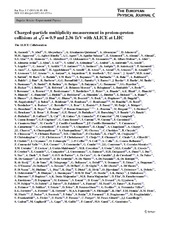Charged-particle multiplicity measurement in proton–proton collisions at √s = 0.9 and 2.36 TeV with ALICE at LHC
The ALICE Collaboration; Aamodt, K.; Abel, N.; Alme, Johan; Bablok, Sebastian Robert; Haaland, Øystein Senneset; Huang, M.; Kanaki, Kalliopi; Larsen, Dag Toppe; Nystrand, J.; Pommeresche, Bjørn; Skjerdal, Kyrre; Wagner, B.
Peer reviewed, Journal article
Published version
Permanent lenke
https://hdl.handle.net/1956/4580Utgivelsesdato
2010-07-12Metadata
Vis full innførselSamlinger
Originalversjon
https://doi.org/10.1140/epjc/s10052-010-1339-xSammendrag
Charged-particle production was studied in proton–proton collisions collected at the LHC with the ALICE detector at centre-of-mass energies 0.9 TeV and 2.36 TeV in the pseudorapidity range |η|<1.4. In the central region (|η|<0.5), at 0.9 TeV, we measure charged-particle pseudorapidity density dNch/dh = 3.02±0.01(stat.)+0.08-0.05(syst.)dNchd=302001(stat)+008−005(syst) for inelastic interactions, and dNch/dh = 3.58±0.01(stat.)+0.12-0.12(syst.)dNchd=358001(stat)+012−012(syst) for non-single-diffractive interactions. At 2.36 TeV, we find dNch/dh = 3.77±0.01(stat.)+0.25-0.12(syst.)dNchd=377001(stat)+025−012(syst) for inelastic, and dNch/dh = 4.43±0.01(stat.)+0.17-0.12(syst.)dNchd=443001(stat)+017−012(syst) for non-single-diffractive collisions. The relative increase in charged-particle multiplicity from the lower to higher energy is 24.7%±0.5%(stat.)+5.7-2.8%(syst.)247%05%(stat)+57−28%(syst) for inelastic and 23.7%±0.5%(stat.)+4.6-1.1%(syst.)237%05%(stat)+46−11%(syst) for non-single-diffractive interactions. This increase is consistent with that reported by the CMS collaboration for non-single-diffractive events and larger than that found by a number of commonly used models. The multiplicity distribution was measured in different pseudorapidity intervals and studied in terms of KNO variables at both energies. The results are compared to proton–antiproton data and to model predictions.
Beskrivelse
Utgiver
SpringerOpphavsrett
CERN for the benefit of the ALICE collaboration 2010Copyright CERN for the benefit of the ALICE collaboration 2010. This article is published with open access at Springerlink.com

